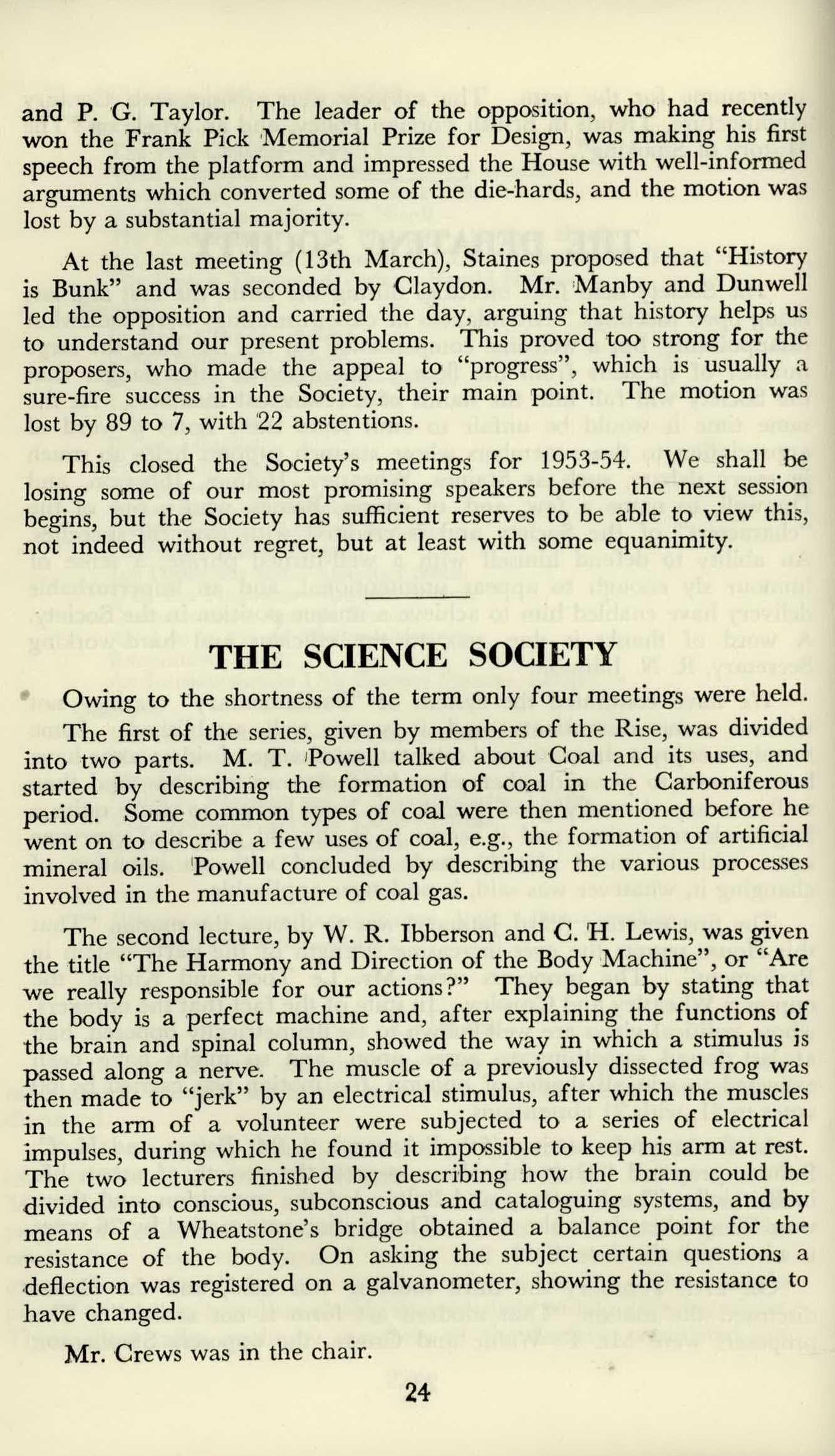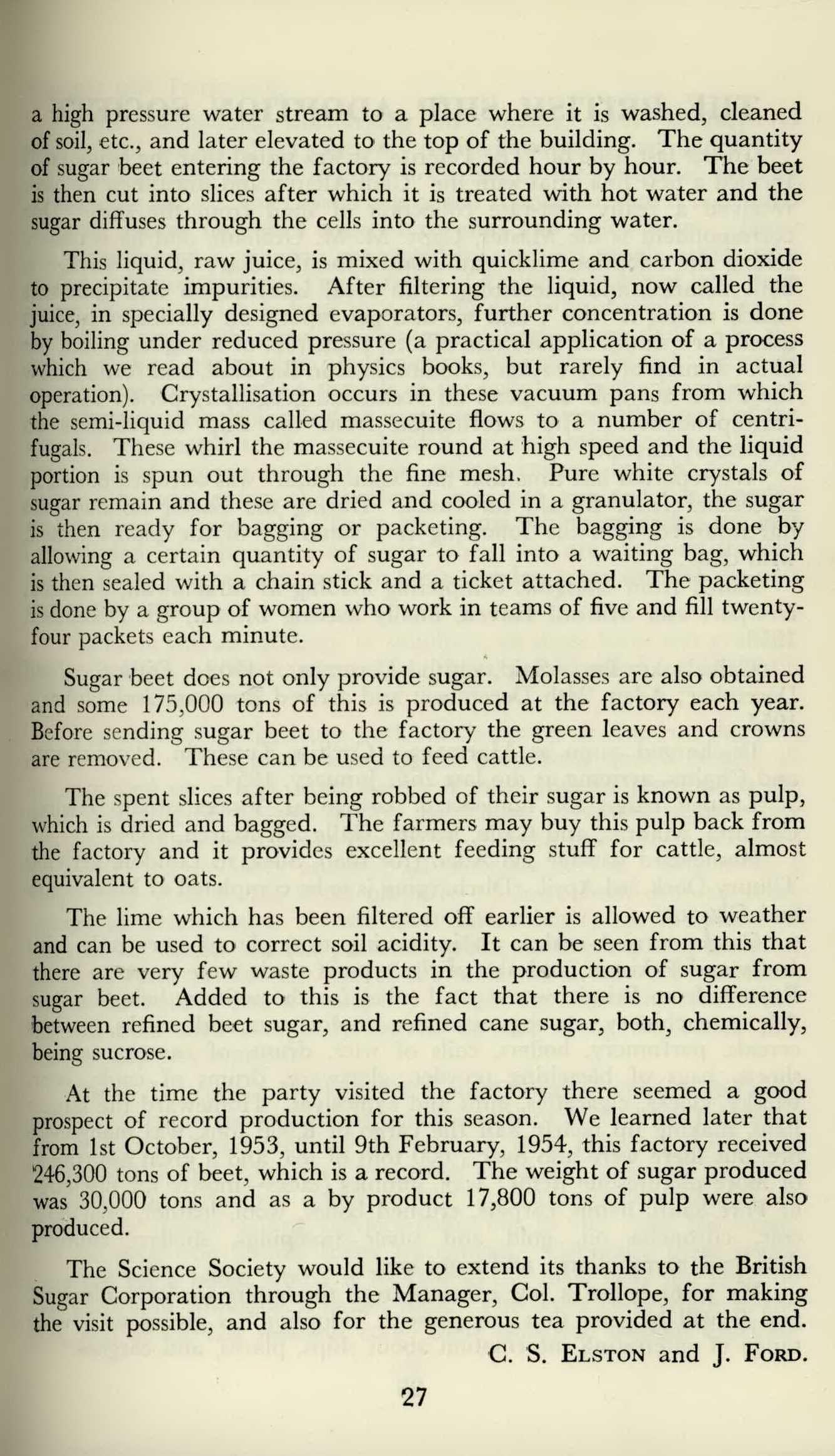
9 minute read
The Science Society
from May 1954
by StPetersYork
and P. G. Taylor. The leader of the opposition, who had recently won the Frank Pick Memorial Prize for Design, was making his first speech from the platform and impressed the House with well-informed arguments which converted some of the die-hards, and the motion was lost by a substantial majority.
At the last meeting (13th March), Staines proposed that "History is Bunk" and was seconded by Claydon. Mr. Manby and Dunwell led the opposition and carried the day, arguing that history helps us to understand our present problems. This proved too strong for the proposers, who made the appeal to "progress", which is usually a sure-fire success in the Society, their main point. The motion was lost by 89 to 7, with 22 abstentions.
This closed the Society's meetings for 1953-54. We shall be losing some of our most promising speakers before the next session begins, but the Society has sufficient reserves to be able to view this, not indeed without regret, but at least with some equanimity.
Owing to the shortness of the term only four meetings were held.
The first of the series, given by members of the Rise, was divided into two parts. M. T. 'Powell talked about Coal and its uses, and started by describing the formation of coal in the Carboniferous period. Some common types of coal were then mentioned before he went on to describe a few uses of coal, e.g., the formation of artificial mineral oils. 'Powell concluded by describing the various processes involved in the manufacture of coal gas.
The second lecture, by W. R. Ibberson and C. H. Lewis, was given the title "The Harmony and Direction of the Body Machine", or "Are we really responsible for our actions?" They began by stating that the body is a perfect machine and, after explaining the functions of the brain and spinal column, showed the way in which a stimulus is passed along a nerve. The muscle of a previously dissected frog was then made to "jerk" by an electrical stimulus, after which the muscles in the arm of a volunteer were subjected to a series of electrical impulses, during which he found it impossible to keep his arm at rest. The two lecturers finished by describing how the brain could be divided into conscious, subconscious and cataloguing systems, and by means of a Wheatstone's bridge obtained a balance point for the resistance of the body. On asking the subject certain questions a deflection was registered on a galvanometer, showing the resistance to have changed.
Mr. Crews was in the chair.
The second meeting consisted of two films shown under the general title of "The aims of industry". "War under the microscope" was the first, and dealt with the discovery, control and prevention of malaria. It began by tracing the history of malaria from the time of the early Greeks, but not until the turn of this century was the real cause discovered, this being a small parasite, plasmodium, which destroys the red corpuscles of the blood. The question now arose as to how the plasmodia were transplanted from person to person. The answer to this was provided by Major Ross, of the Indian Army, later to become Dr. Sir Ronald Ross, who after many years of hard work discovered the carrier to be the female mosquito. The film ended by describing some of the new drugs such as paludrin, and modern methods of malaria control.
The second film was a short one with the title of "A De Havilland Diary", and was concerned with outstanding achievements in post-war aeronautics such as Geoffry De Havilland's first flight in the D.H.108, the altitude record made by Cunningham in 1948, and John Derry's closed circuit record. In conclusion all the planes mentioned were shown being put through their paces at a Farnborough Air Show.
Mr. Robinson was in the chair.
The third meeting was contributed by members of School House.
R. G. Le Pla opened the proceedings by giving a lecture entitled "The Science of Wines". The production of wines for human consumption is essentially a fermentation process. Their manufacture originated in Persia where people started to drink grape juice which had undergone natural fermentation. The juice from grapes is obtained usually by treading methods, after which the "blume" previously on the outside of the grape comes in contact with the juice, and it is this which causes fermentation to take place. The primary fermentation takes place in the Autumn followed by a subsidiary one in the Spring. It is at this stage that other alcoholic wines of differing blends and concentrations may be added, in which case the original wine is said to be fortified. Le Pla finished his lecture by describing how sparkling wines, i.e., champagne, are produced by the artificial addition of carbon dioxide at a pressure of 90 lbs./sq. in.
A. G. Hall continued the evening's programme by giving a very instructive talk on "How to set up a tropical aquarium". After deciding on the requirements of the fish that are to be kept, the bottom of the tank is laid out with clean gravel. Selected weeds may then be added, a lead weight being attached to their roots in order to hold them down. Finally some "top" weed is added, which is especially good cover for young fry. The last thing to do before the addition of the fish is to heat the tank to about 76°F. An electric heating heating element controlled by a thermostat is the usual method, but an electric bulb of specified wattage (determined by the size of the tank) placed underneath may be used as an alternative.
25

The final lecture was given by C. C. S. Chapman on "Atom Defence". He described the different effects produced by detonations at various heights, and then went on to talk about the radiation produced. This may be divided into three parts (i) alpha particles which have no penetrating powers and are of little significance, (ii) beta particles which burn the skin, and (iii) gamma rays which are very penetrating, and do a great deal of harm, especially to the tissues of the body. The lecturer then showed by means of a chart the effective distance of radiation, heat-flash and blast and finished by describing a theoretical atomic bomb. J. McCallum was in the chair
The final lecture of the term was one on electronics and its applications in industry, given by Mr. P. R. Strong.
The lecturer dealt with the subject on an empirical basis instead of running into great detail.
The diode was the first valve he dealt with, its main property being the ability to convert A.C. to D.C. by allowing the passage of only positive half-cycles. The diode conducts only when the anode is positive with respect to the cathode. Mr. Strong described as an application how its limiting properties might be made use of for such an instrument as a strain gauge.
In the triode valve, which is not so far removed from the diode, the grid gives complete control over the anode current.
A photoelectric cell makes use of the fact that selenium when on a plate will develop a current between itself and the plate when light falls on it. Such a cell is often used in a factory chimney to assess the amount of smoke being generated. Selenium cells do not as a rule burn out, but the substance itself is susceptible to impurities.
The lecturer concluded by describing how a short duration impulse might be produced, and gave a short introduction to electronic heating effects.
Mr. Robinson was in the chair.

VISIT TO POPPLETON SUGAR BEET FACTORY, 27th JANUARY, 1954
The party, consisting of members of the Science Society, was first of all shown an introductory film, the purpose of which was to give a brief plan of the arrangement of the factory.
The guide then showed us where the sugar beet is unloaded from the railway trucks and lorries. This is done by tipping the beet into large concrete storage bins, from which it is moved by means of
26
a high pressure water stream to a place where it is washed, cleaned of soil, etc., and later elevated to the top of the building. The quantity of sugar beet entering the factory is recorded hour by hour. The beet is then cut into slices after which it is treated with hot water and the sugar diffuses through the cells into the surrounding water.
This liquid, raw juice, is mixed with quicklime and carbon dioxide to precipitate impurities. After filtering the liquid, now called the juice, in specially designed evaporators, further concentration is done by boiling under reduced pressure (a practical application of a process which we read about in physics books, but rarely find in actual operation). Crystallisation occurs in these vacuum pans from which the semi-liquid mass called massecuite flows to a number of centrifugals. These whirl the massecuite round at high speed and the liquid portion is spun out through the fine mesh. Pure white crystals of sugar remain and these are dried and cooled in a granulator, the sugar is then ready for bagging or packeting. The bagging is done by allowing a certain quantity of sugar to fall into a waiting bag, which is then sealed with a chain stick and a ticket attached. The packeting is done by a group of women who work in teams of five and fill twentyfour packets each minute.
Sugar beet does not only provide sugar. Molasses are also obtained and some 175,000 tons of this is produced at the factory each year. Before sending sugar beet to the factory the green leaves and crowns are removed. These can be used to feed cattle.
The spent slices after being robbed of their sugar is known as pulp, which is dried and bagged. The farmers may buy this pulp back from the factory and it provides excellent feeding stuff for cattle, almost equivalent to oats.
The lime which has been filtered off earlier is allowed to weather and can be used to correct soil acidity. It can be seen from this that there are very few waste products in the production of sugar from sugar beet. Added to this is the fact that there is no difference between refined beet sugar, and refined cane sugar, both, chemically, being sucrose.
At the time the party visited the factory there seemed a good prospect of record production for this season. We learned later that from 1st October, 1953, until 9th February, 1954, this factory received 246,300 tons of beet, which is a record. The weight of sugar produced was 30,000 tons and as a by product 17,800 tons of pulp were also produced.
The Science Society would like to extend its thanks to the British Sugar Corporation through the Manager, Col. Trollope, for making the visit possible, and also for the generous tea provided at the end.











